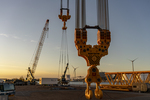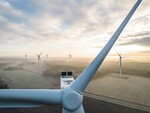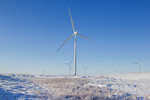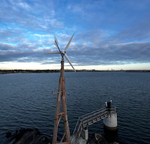03/04/2009
USA - Principle Power raising $20M to build World’s first floating wind farm
Seattle wind energy startup Principle Power is in the process of raising $20 million to develop wind farms in the deep waters off the coast of Oregon and other locations. The financing deal is expected to close in the second quarter of this year, according to Principle Power CEO Alla Weinstein.
“We’re talking to a number of strategic investors,” says Weinstein, who adds that none of them are in the Seattle area, and none are venture capital firms. Last April, Principle Power raised $2.3 million from angel investors, most from the San Francisco area (many of them affiliated with the Keiretsu Forum angel network), and some in Europe. The company signed an agreement with Tillamook People’s Utility District in November to develop a 150-megawatt wind-power plant off the coast of Tillamook County, Oregon. And two weeks ago, Principle Power announced a deal with EDP, Portugal’s largest energy utility, to build a wind farm off the Portuguese coast.
Offshore wind turbines are not new, but all existing systems rest on the ocean floor in relatively shallow water. As Weinstein explains, there are two main reasons for putting wind farms offshore in the first place: to decrease their visual impact on residents and tourists, and to gain access to stronger and more consistent winds. The problem is that along many shorelines, like the West Coast of the U.S., the ocean gets deep fast. Go out just a few miles, and the water is already more than 40 meters deep—which causes major technical problems with conventional turbine installation and maintenance.
That’s where Principle Power’s technology comes to the fore. The company’s patent-pending foundation, WindFloat, is designed to support a 400-ton wind turbine and keep all of its associated machinery afloat (and properly aligned) in raging ocean swells—hardly an easy task. The platform is triangle-shaped, with the turbine sitting atop one corner; all three corners have submerged legs, or columns, that help stabilize the platform, Weinstein says. The columns, which are connected by trusses, are moored to the ocean floor and contain “water-entrapment plates” that keep the platform very stable at low cost, allowing the company to use off-the-shelf offshore wind turbine generators. The foundation is assembled on a wharf and then towed out to sea, which makes its installation manageable.
Until now, Denmark and the UK have led the world in offshore wind—so how did the Pacific Northwest get on the map? Weinstein, a Russian native and Honeywell veteran, previously founded AquaEnergy Group in Seattle, an ocean wave-energy company that was acquired in 2006 by Vancouver, BC-based Finavera Renewables. In October 2007, she co-founded Principle Power with Jon Bonanno, the company’s president.
To get the right technology, they started talking with Berkeley, CA-based Marine Innovation & Technology, which originally designed the WindFloat for offshore oil and gas rigs, and signed an exclusive licensing agreement last June. “We licensed WindFloat, and are now converting it into ownership,” Weinstein says.
But commercial floating wind farms are still several years away. Weinstein says WindFloat passed its technical tests, done in experimental water tanks, in October. Now it’s a matter of dealing with federal and state regulations, and obtaining permits to build and operate offshore wind turbines. Weinstein says the “talks with Portugal may advance faster” than Oregon, and that the technology could be deployed abroad in two to three years.
And why not Washington state? Weinstein points out that two-thirds of Washington’s coastline is designated as a marine sanctuary—which rules out building wind farms and laying underwater power-transmission cables. “That’s why we went to Oregon,” Weinstein says. “But we can bring the power back to Washington. I would like to see both governors come together and say, ‘We have the ocean, it can provide all the power you need. Why don’t we use that?’”
As for the Northwest’s attitudes about renewable energy, Weinstein says, “With my first company, doing wave energy, it was, ‘Who are you, what are you doing?’ But wind energy is closer to commercialization than wave energy. There is lots of interest and receptiveness…We’re going to be floating in the Pacific Northwest. With the [federal government's] stimulus package, I’m hoping we’ll see development a lot quicker.”
For more information please contact Trevor Sievert at ts@windfair.net
“We’re talking to a number of strategic investors,” says Weinstein, who adds that none of them are in the Seattle area, and none are venture capital firms. Last April, Principle Power raised $2.3 million from angel investors, most from the San Francisco area (many of them affiliated with the Keiretsu Forum angel network), and some in Europe. The company signed an agreement with Tillamook People’s Utility District in November to develop a 150-megawatt wind-power plant off the coast of Tillamook County, Oregon. And two weeks ago, Principle Power announced a deal with EDP, Portugal’s largest energy utility, to build a wind farm off the Portuguese coast.
Offshore wind turbines are not new, but all existing systems rest on the ocean floor in relatively shallow water. As Weinstein explains, there are two main reasons for putting wind farms offshore in the first place: to decrease their visual impact on residents and tourists, and to gain access to stronger and more consistent winds. The problem is that along many shorelines, like the West Coast of the U.S., the ocean gets deep fast. Go out just a few miles, and the water is already more than 40 meters deep—which causes major technical problems with conventional turbine installation and maintenance.
That’s where Principle Power’s technology comes to the fore. The company’s patent-pending foundation, WindFloat, is designed to support a 400-ton wind turbine and keep all of its associated machinery afloat (and properly aligned) in raging ocean swells—hardly an easy task. The platform is triangle-shaped, with the turbine sitting atop one corner; all three corners have submerged legs, or columns, that help stabilize the platform, Weinstein says. The columns, which are connected by trusses, are moored to the ocean floor and contain “water-entrapment plates” that keep the platform very stable at low cost, allowing the company to use off-the-shelf offshore wind turbine generators. The foundation is assembled on a wharf and then towed out to sea, which makes its installation manageable.
Until now, Denmark and the UK have led the world in offshore wind—so how did the Pacific Northwest get on the map? Weinstein, a Russian native and Honeywell veteran, previously founded AquaEnergy Group in Seattle, an ocean wave-energy company that was acquired in 2006 by Vancouver, BC-based Finavera Renewables. In October 2007, she co-founded Principle Power with Jon Bonanno, the company’s president.
To get the right technology, they started talking with Berkeley, CA-based Marine Innovation & Technology, which originally designed the WindFloat for offshore oil and gas rigs, and signed an exclusive licensing agreement last June. “We licensed WindFloat, and are now converting it into ownership,” Weinstein says.
But commercial floating wind farms are still several years away. Weinstein says WindFloat passed its technical tests, done in experimental water tanks, in October. Now it’s a matter of dealing with federal and state regulations, and obtaining permits to build and operate offshore wind turbines. Weinstein says the “talks with Portugal may advance faster” than Oregon, and that the technology could be deployed abroad in two to three years.
And why not Washington state? Weinstein points out that two-thirds of Washington’s coastline is designated as a marine sanctuary—which rules out building wind farms and laying underwater power-transmission cables. “That’s why we went to Oregon,” Weinstein says. “But we can bring the power back to Washington. I would like to see both governors come together and say, ‘We have the ocean, it can provide all the power you need. Why don’t we use that?’”
As for the Northwest’s attitudes about renewable energy, Weinstein says, “With my first company, doing wave energy, it was, ‘Who are you, what are you doing?’ But wind energy is closer to commercialization than wave energy. There is lots of interest and receptiveness…We’re going to be floating in the Pacific Northwest. With the [federal government's] stimulus package, I’m hoping we’ll see development a lot quicker.”
For more information please contact Trevor Sievert at ts@windfair.net
- Source:
- Principle Power
- Author:
- Edited by Trevor Sievert, Online Editorial Journalist / Author: Principle Power Staff
- Email:
- ts@windfair.net
- Link:
- www.windfair.net/...
- Keywords:
- wind energy, renewable energy, wind turbine, wind power, wind farm, rotorblade, onshore, offshore, Principle Power
- Wind Energy Wiki:
- Wave Energy


























